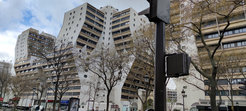Jews and Muslims in the 19th arrondissement of Paris: face to face, or side by side?
by Nonna Mayer
Nonna Mayer is research professor at Sciences Po, CEE, CNRS nonna.mayer@sciencespo.fr.

A profusion of opinion polls in the two last decades has been exploring the relations between Jews and Muslims in France, a country that hosts the largest Jewish community in Europe (around 500 000) as well as one of the largest Muslim one (between 5 and 6 million). Yet there are many limitations to this type of survey. Sampling problems are central, because of the small number of both religious minorities in the total population, and because “ethnic” statistics are banned in France so no census data on religion is available. Surveys give more attention to how Muslims see Jews than the reverse. They often are framed negatively, focusing on prejudice, driven by “new” antisemitism theories focused on the rise of antisemitism in the Muslim world and in the suburbs, structured by antizionism and the hate of Israel. Last, they tend to isolate and essentialize “Jews” and “Muslim”. People are not only defined by their religion, but one also needs to look at how religion intersects with origin, class, generation, or gender. And one must compare Jews and Muslims to other religious/cultural groups.
Keeping in mind these limitations, Vincent Tiberj, Elodie Druez and I designed a contextualized survey (Zuckerman et al, 2005;Braconnier 2010 ) we considered more adapted to the research aims of the Encounters project https://www.mmg.mpg.de/640536/encounters-ora-joint-research-project , taking model on a previous survey we conducted in 2019 on intercultural relations in the town of Sarcelles, in the suburbs of Paris (https://brill.com/display/book/9789004514331/BP000011.xml). For the Encounters fieldwork we chose the 19th arrondissement of Paris. The 19th is a socially mixed arrondissement, where gentrified areas coexist with poor neighborhoods, and where the average poverty rate rises to 24.4%, 8 percentage points above the Paris average. It also is ethnically diverse, hosting large numbers of Jews and Muslims often living side by side. The arrondissement has become in the last three decades a stronghold of the Lubavitch movement, with a predominantly Sephardic audience, and the highest number of synagogues (30) and Jewish schools in Paris. One quarter of the population has an immigrant background (born foreigner abroad), 5 percentage points above the Paris average, the majority of which coming from Maghreb and Sub-Saharan Africa (57% vs 42%), in other words from mostly Muslim countries. There are a dozen Muslim places of worship in the 19th.

As in Sarcelles we opted for a telephone survey, conducted in December 2022. The sample (N=of755) was designed to be representative of all people living in the 19th, with just a focus on the neighborhoods where Jews and immigrants live together, mapped thanks to a preparatory work by Elodie Druez, crossing census data on immigration and Lucine Endelstein’s ethnographic data on the Jewish sections of the arrondissement (see map).

The questionnaire is meant to go beyond the usual racist/antisemitic stereotypes. It explores with open and closed questions the social/political/cultural identity of respondents and their perceptions of “us” and “them »,including all the groups present in the neighborhood, not only Jews and Muslim. More concretely to go deeper in their social and cultural relations it investigated their patterns of sociability, who they saw, with whom they went out, what they ate, which school they sent their children to etc. Survey experiments deal with more sensitive issues-such as islamophobic/ anti-semitic/anti-Christian cartoons at school, or police reactions to verbal assault according to the ethnicity of the victim- with vignettes randomly proposed to subsamples. Last the individual data is connected with contextual data, using census information to specify the social and demographic characteristics of the respondent’s environment at the IRIS level (Ilots Regroupés pour l'Information Statistique /Aggregated units for statistical information), the smallest territorial unit available, from 2000 to 2500 people on average.

We just started analyzing the data, this is work in progress, but the results already confirm what we found in Sarcelles, going against many common beliefs. Religion is not the only dimension of the respondents’ identity, class and gender count as much, if not more. The relations between Jews and Muslims are not, by essence, conflictual. There are points of disagreement (on Israel, on the colonial past of France). Old antisemitic stereotypes about Jews sticking together or having more influence persist, not limited to Muslims. But both groups have much in common: they are more religious than the majority population, more traditional on sexual issues, more family oriented. They massively accept the idea of having dinner with people of another religion. And they massively agree that Jews and Muslims have a common cultural heritage (67% each very much/somewhat approve) and should be united against discrimination (78% and 91%).















